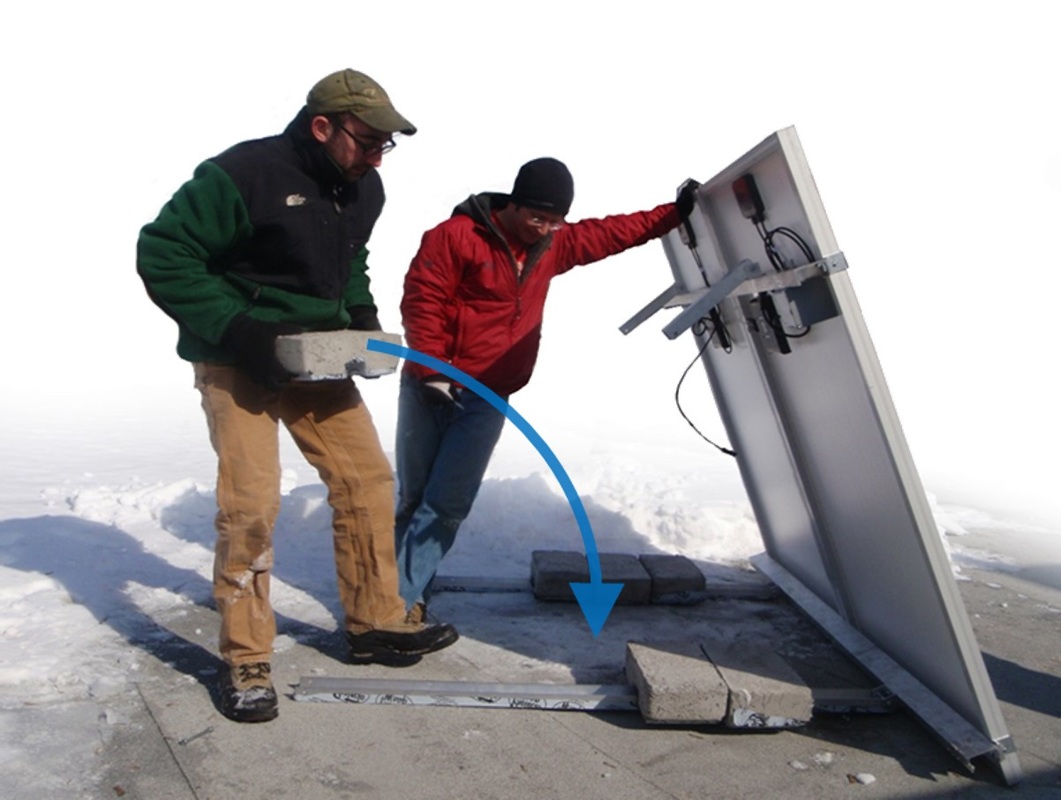Simplifying the installation of Solar PV on flat roofsEngineering Design Methodology / Norwich Technologies, Fall 2013 - Winter 2014
Project Manager, Lead Designer |
Skills
SolidWorks, FEA Analysis SolidWorks Composer ASCE Building Code Machining Concrete Casting |
|
|
I worked in a team of three to design, build, and test a low-cost ballast mount system for a local solar company, Norwich Technologies. Our project sponsors wanted a mount that was both simple to manufacture and easy to install.
Ballasted Mounts use only weight to hold solar panels on flat roofs. This weight must hold the mount down against wind loads, but not overload the roof structure. The panels are held at an angle to improve efficiency and shed snow. Norwich Tech’s existing solar technology, EZ-PV, is a 5 panel pitched roof mount that can be rapidly fabricated in their small shop, then placed on a roof with a crane and mounted with minimal on-site time. They wanted to see the same pre-fab concept applied to a flat roof mount.
Using a simple design adapted from the EZ-PV pitched roof mount as a basis, I worked with ASCE building codes to determine wind and snow loadings, conducted FEA analysis in SolidWorks on all loading conditions, and explored economic considerations of materials use and fabrication time. We also built our design to get tactile experience of handling and moving the mount.
The main challenge in our design was finding a balance between installation ease and fabrication cost. We explored numerous concepts of varying complexity to allow the mount to fold flat for transport, then be easily unfolded on the roof to put the panels at an optimum pitch. I brought several designs from initial sketch concept to final working prototype on our path to a final solution. I evaluated our physical prototypes for ease of fabrication and installation and conducted FEA analysis and hand calculations on all critical loading conditions to ensure that our designs were structurally sound.
We had assumed that there was no room for improvement in the most widely used technique of placing standard concrete blocks in ballast trays. However, testing ballast placement on our prototypes exposed some usability problems. With Norwich Tech’s goal of a pre-fabricated mount in mind, we had to figure out a better way to install ballast.
Our “Aha!” moment came when we tilted up the panels on one of our prototypes. That would allow for much easier placement of ballast. Designing a simple custom ballast block solved the ergonomic struggles of gripping a standard block and eliminated the need for any extra ballast trays to hold the ballast.
Our “Aha!” moment came when we tilted up the panels on one of our prototypes. That would allow for much easier placement of ballast. Designing a simple custom ballast block solved the ergonomic struggles of gripping a standard block and eliminated the need for any extra ballast trays to hold the ballast.
After fabricating our final prototype, including casting our custom concrete ballast blocks, we tested installation on Norwich Tech’s roof. The un-ballasted mount at only 50 lbs can comfortably be lifted by two people. Placement of ballast was easy, with one person holding the panels up while the other sets ballast on the base rails.
Our final prototype combined a simple and low cost c-channel frame with custom cast concrete ballast blocks for a unique installation scheme. The frame is extremely simple to fabricate and requires no more than a cutoff saw and a drill press, ideal for Norwich Tech’s small workshop. With all assembly done in the shop, only two bolts need to be installed on the roof after the ballast is placed.
Our final deliverables to Norwich Tech included engineering drawings of all the parts of the mount as well as a detailed assembly manual created using SolidWorks Composer. This was in addition to all of our design and calculation tools we developed for wind and snow loading analysis. Norwich Technologies was very pleased with our work on the project. At the end of the year, our project was awarded the Dartmouth Society of Engineers Prize for outstanding performance.
Our final deliverables to Norwich Tech included engineering drawings of all the parts of the mount as well as a detailed assembly manual created using SolidWorks Composer. This was in addition to all of our design and calculation tools we developed for wind and snow loading analysis. Norwich Technologies was very pleased with our work on the project. At the end of the year, our project was awarded the Dartmouth Society of Engineers Prize for outstanding performance.












